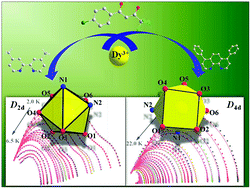当前位置:
X-MOL 学术
›
Dalton Trans.
›
论文详情
Our official English website, www.x-mol.net, welcomes your
feedback! (Note: you will need to create a separate account there.)
The slow magnetic relaxation regulated by the coordination, configuration and intermolecular dipolar field in two mononuclear DyIII single-molecule magnets (SMMs)†
Dalton Transactions ( IF 3.5 ) Pub Date : 2018-08-08 00:00:00 , DOI: 10.1039/c8dt02361a Sheng Zhang 1, 2, 3, 4, 5 , Wenjiao Mo 1, 2, 3, 4 , Bing Yin 4, 6, 7, 8, 9 , Gaini Zhang 1, 2, 3, 4 , Desuo Yang 1, 2, 3, 4 , Xingqiang Lü 4, 5, 8, 10, 11 , Sanping Chen 4, 6, 7, 8, 9
Dalton Transactions ( IF 3.5 ) Pub Date : 2018-08-08 00:00:00 , DOI: 10.1039/c8dt02361a Sheng Zhang 1, 2, 3, 4, 5 , Wenjiao Mo 1, 2, 3, 4 , Bing Yin 4, 6, 7, 8, 9 , Gaini Zhang 1, 2, 3, 4 , Desuo Yang 1, 2, 3, 4 , Xingqiang Lü 4, 5, 8, 10, 11 , Sanping Chen 4, 6, 7, 8, 9
Affiliation

|
Tuning the magnetic dynamics of single-molecule magnets (SMMs) is a crucial challenge for chemists. Some feasible approaches have been developed to understand parts of the magneto-structural correlations and regulate the relaxation behaviors via rational design. Herein, the syntheses, structures and magnetic properties of two mononuclear DyIII SMMs are reported. The first structural motif reveals a trigonal dodecahedron (D2d) N2O6 coordination environment in 1, while the second one displays a square antiprismatic configuration (D4d). A Dy⋯Dy distance of 8.589 Å in 1 is clearly shorter than that of 2 (10.433 Å) because of the existence of π⋯π stacking between benzene rings from two adjacent dbpy molecules in 1. The temperature and frequency-dependent out-of-phase ac susceptibility peaks were observed in the absence of a static dc field for 1 and 2. Two distinct thermal relaxation processes were observed in 1, while 2 exhibits one thermal relaxation process. It is interesting that the quantum tunneling of magnetization (QTM) was suppressed when optimum dc fields (1000 Oe) were applied. From ab initio calculations, the energies of the first excited state (KD1) are indeed close to the experimental relaxation energy barrier (Ueff) under zero dc field, which also reveals the typical features associated with the SMM behavior. In detail, the Ueff values are 103.62 cm−1 (149.87 K) as well as 55.10 cm−1 (79.69 K) for 1 and 116.07 cm−1 (167.87 K) for 2. The KD1 of 1 (133.82 cm−1) is slightly higher than that of 2 (129.31 cm−1). Comparing 1 and 2, this discrepancy from KD1 and the experimental Ueff might come from the apparent difference in the magnitude of tunneling probability between the two compounds. In other words, the intermolecular dipolar field plays an important role in their magnetic properties.
中文翻译:

慢磁弛豫受两个单核Dy III单分子磁体(SMM)的配位,构型和分子间偶极场的调节†
调整单分子磁体(SMM)的磁动力学是化学家面临的关键挑战。已经开发出一些可行的方法来理解部分磁结构相关性,并通过合理的设计来调节弛豫行为。本文报道了两种单核Dy III SMM的合成,结构和磁性。第一结构基序揭示了一个三角形的十二面体(d 2D)N 2 ö 6在配位环境1,而第二个显示一个方形反棱柱构型(d 4D)。在8.589埃的镝⋯镝距离1比的较短的清楚2(10.433Å),因为在1中来自两个相邻dbpy分子的苯环之间存在π⋯π堆积。在没有静态直流场的情况下,对于1和2观察到温度和频率相关的异相磁化率峰值。在1中观察到两个不同的热弛豫过程,而2则显示一个热弛豫过程。有趣的是,当应用最佳直流场(1000 Oe)时,磁化的量子隧道效应(QTM)被抑制。从从头计算,第一激发态的能量(KD 1)确实接近实验松弛能量势垒(Ûeff)在零直流磁场下,这也揭示了与SMM行为相关的典型特征。详细地, û EFF值103.62厘米-1(149.87 K)以及55.10厘米-1(79.69 K)为1和116.07厘米-1(167.87 K)为2。对KD 1的1(133.82厘米-1)比略高2(129.31厘米-1)。比较1和2,与KD 1和实验U eff的差异可能是由于这两种化合物之间的隧穿概率大小存在明显差异。换句话说,分子间偶极场在其磁性能中起重要作用。
更新日期:2018-08-08
中文翻译:

慢磁弛豫受两个单核Dy III单分子磁体(SMM)的配位,构型和分子间偶极场的调节†
调整单分子磁体(SMM)的磁动力学是化学家面临的关键挑战。已经开发出一些可行的方法来理解部分磁结构相关性,并通过合理的设计来调节弛豫行为。本文报道了两种单核Dy III SMM的合成,结构和磁性。第一结构基序揭示了一个三角形的十二面体(d 2D)N 2 ö 6在配位环境1,而第二个显示一个方形反棱柱构型(d 4D)。在8.589埃的镝⋯镝距离1比的较短的清楚2(10.433Å),因为在1中来自两个相邻dbpy分子的苯环之间存在π⋯π堆积。在没有静态直流场的情况下,对于1和2观察到温度和频率相关的异相磁化率峰值。在1中观察到两个不同的热弛豫过程,而2则显示一个热弛豫过程。有趣的是,当应用最佳直流场(1000 Oe)时,磁化的量子隧道效应(QTM)被抑制。从从头计算,第一激发态的能量(KD 1)确实接近实验松弛能量势垒(Ûeff)在零直流磁场下,这也揭示了与SMM行为相关的典型特征。详细地, û EFF值103.62厘米-1(149.87 K)以及55.10厘米-1(79.69 K)为1和116.07厘米-1(167.87 K)为2。对KD 1的1(133.82厘米-1)比略高2(129.31厘米-1)。比较1和2,与KD 1和实验U eff的差异可能是由于这两种化合物之间的隧穿概率大小存在明显差异。换句话说,分子间偶极场在其磁性能中起重要作用。











































 京公网安备 11010802027423号
京公网安备 11010802027423号